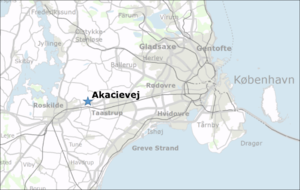Introduction and background
| Highlights |
|---|
|
IntroductionThis Wiki is part of the Region H Limestone Project, a collaboration between DTU Environment at the Technical University of Denmark and Region H about the fate of contaminants in fractured limestone aquifers. The limestone project aims at improving our understanding of contaminant transport in fractured limestone aquifers and to identify and develop appropriate tools for the assessment and remedial planning of contaminated sites. The project involves a combination of field and lab work, and modeling of field data. The goals of the Region H Limestone Project are to
This Wiki summarizes the major outcomes of the project and is an information source about contaminant transport in fractured limestone aquifers. BackgroundLimestone aquifers are important drinking water resources. In Denmark, for example, about one third of the drinking water is abstracted from limestone aquifers. Limestone aquifers provide usually high-quality drinking water, which does not need much treatment before it can be supplied to the consumers. However, these aquifers are often threatened by pollutants from contaminated sites. For the protection of such drinking water resources, the understanding of the fate and transport behavior of contaminants from contaminated sites in limestone aquifers is important. This is challenging, because limestone aquifers are often heavily fractured and may contain chert layers and nodules, resulting in a complex flow and transport behavior, which is difficult to predict. Standard methods used for unfractured sites (e.g. sandy aquifers) may give poor or misleading results and more advanced techniques, which consider the processes in both, the fractures and the limestone matrix, are required. Different field methods have been developed in the past to better characterize the flow field and transport behavior in fractured aquifers. Moreover, specialized methods for determining aquifer parameters and estimating the contaminant distribution in fractured aquifers have been shown to be useful and are discussed in this Wiki. As contaminants, dissolved chlorinated solvents (PCE, TCE etc.) are considered in this Wiki, but the insights can also be transferred to other dissolved contaminants. Another focus of the Limestone Wiki is on modeling techniques for contaminant transport in fractured limestone aquifers. Numerical models are essential tools for the prediction of the contaminant behavior in an aquifer and for the planning of remedial actions. They can be very useful for the planning and interpretation of field work. It is, however, important to select an appropriate model, which accounts for the fractured nature of the aquifer and does not oversimplify the studied system. Then, it can be used a very useful tool to improve the conceptual understanding and to guide with decision support for risk assessment and remedial site management. This Wiki aims at giving an overview of recent field methods and modeling tools and at evaluating their applicability in fractured limestone aquifers. It describes and evaluates some useful methods for the determination of relevant field data and for the assessment of contaminant plumes in fractured limestone aquifers. To test field methods and modeling tools and to enhance the conceptual understanding of contaminant transport in fractured limestone aquifers, a representative field site with a PCE contamination in limestone was selected. The field site is located west of Copenhagen (see map) and is called Akacievej in the following. It was used to conduct a long-term pumping test combined with multiple tracer injections under forced gradient conditions and to test different depth-discrete contaminant sampling methods. This gave some important insights and the impacts on the conceptual understanding of the processes in fractured limestone are discussed in this Wiki and in two accompanying reports. |
